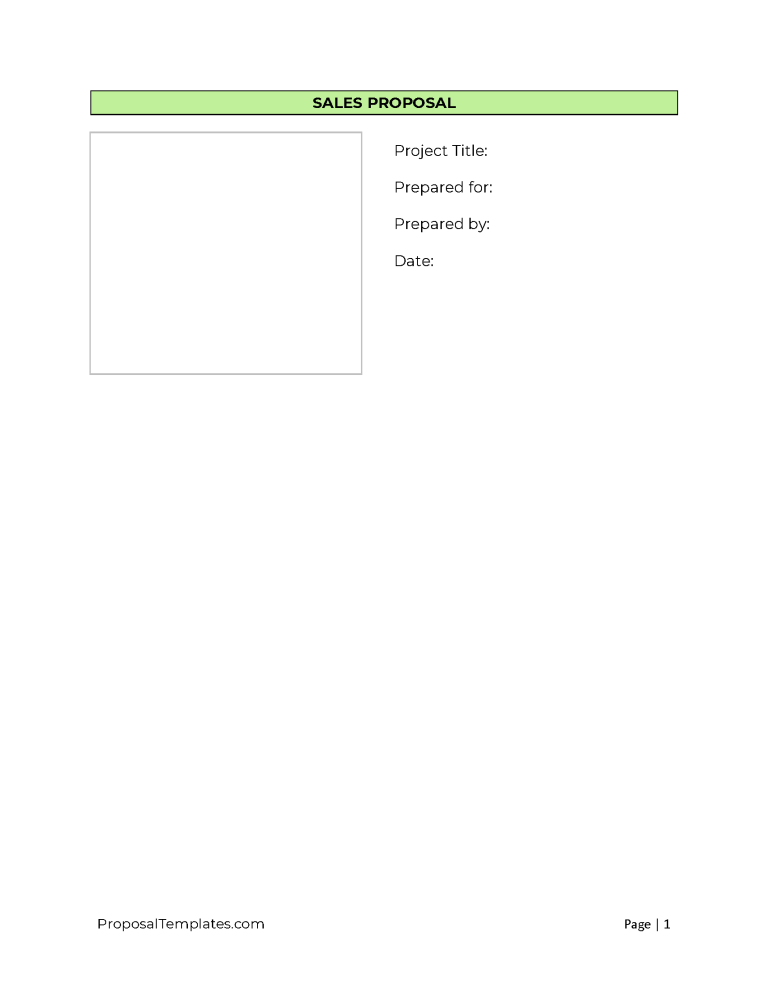A sales proposal is an offer for products or services with a detailed “pitch” as well as a client analysis. It should include a detailed offering overview together with a price comparison. If the client agrees to the terms in the proposal, it should be signed or converted to a business contract.
By Type (10)
What Should Be Included (14 Items) |
1. Cover Page
Supply a cover page for the proposal that shows the sender’s information and purpose as well as the proposal’s title. Also, directly address the sales client by listing their name and contact information.
Seller Company Name, Contact Person
Logo, Company Hours, Contact Information
Attractive or informative Graphics, Slogan
Title, Date, Author
Prospective Client Information
2. Executive Summary
Produce a basic overview of the proposal while keeping each section’s selling points at the forefront. For example, comprehensively present the solution to the client’s challenges.
Proposal Title, Introduction, Client Information
Problem Statement, Needs Assessment
Solution Overview, Value Proposition, Unique Selling Points
Implementation Plan, Timeline, Pricing
Call To Action, Contact Information, Closing Statement
3. Introduction
Write a formal introduction to the sales company with a markedly positive attitude. Also, let the client know you are familiar with their company and want to work with them.
Client Name, Company Profile, Contact Acknowledgement
Appreciation, Understanding, Client Needs
Connection, Relevance, Value Proposition
Confidence, Client Assurance
Call To Action, Contact Information, Relevance
4. Customer Analysis
Give the client a fundamental analysis of their industry status in addition to a history of their challenges. Significantly personalize this area to assure the client that you understand their pain points and the necessary solutions.
Client Background, Demographics, Psychographics
Goals, Pain Points, Challenges
Competitive Analysis, Market Trends
Customer Feedback, Market Research Findings
SWOT Anaylsis, Alignment, Visuals
5. Solutions
Once a well-rounded customer analysis has been presented, propose a solution to their challenges. Specifically, address each obstacle with an answer from the product, service, or subscription being pitched.
Solution Overview, Detailed Description
Features, Capabilities, Customer Options
Implementation, Technical Specification, Use Cases
Value Proposition, ROI, Support, Integration, Compatibility
Scalability, Training, Considerations
6. Product/Service Details
Describe the concerned product, service, or subscription in detail. Simultaneously, remind the client of the seller’s firm belief the goods and services will benefit the client better than any existing competition.
Product/Service Name, Detailed Description
Key Features, Technical Specifications
Compatability, Security, Data Privacy, Training
Onboarding, Maintenance, Pricing, Support
Graphics, Warranty, Packages
7. Testimonials And Case Studies
Present clear evidence of past satisfied clients together with their backgrounds. For example, use direct client quotes about their experience with the seller.
Customer Names/Companies, Disclaimers
Case Studies, Title, Summary, Customer Backgrounds
Customer Needs, Direct Quotes, Testimonials
Previous Customer Challenges/Solutions
Before/After Scenarios And Anecdotes
8. Deliverables
Lay out everything the client receives and when (i.e., samples, promotional items, products, services). Also, present optional packages, pricing, and deliverables that might interest the potential client.
Manifest/Inventory, Product/Service Components
Quantity, Volume, Quality Standards, Timeline
Dependencies, Acceptance Criteria, Client Obligations
Customization, Support, Training, Documentation
Maintenance, Warranty, Guarrantee, Contingencies
9. Unique Selling Proposition
Further define why the product, service, or subscription satisfies the client’s needs while separating it from the competition. For instance, mention any uniquely patented processes involved in manufacturing or subscription discounts.
Client Needs, Value Proposition, Key Benefits
Comptitive Comparison, Previous Customer Quotes
Statistics, Data, Market Research
Innovation, Expertise, Experience
Demonstrations, Samples, Media
10. Social Proof
If relevant, offer evidence of a product or service’s positive impact using reactions or reviews from social media and consumer websites (i.e., Yelp). Remember that the client must remain interested; thus, offer as much proof as possible.
Customer Anecdotes, Quotes, Endorsements
- Photos, Case Studies
- Customer Count, Usage Statistics
- User Ratings, Reviews
- Press Coverage, Media Mentions
11. Costs
Continue with a record of every cost the client must pay whenever this proposal moves on to the next step. That is, give them an easy-to-read breakdown and the total price.
Base Price, Itemized Costs, Pricing Structure
Addons, Upgrades, Promotions, Discounts
Taxes, Fees, Additional Expenses/Costs, Total Cost
Payment Terms, Expiration Date
Terms, Conditions, Clarification
12. Sales Team
Present the sales team roster together with each one’s track record. If the sales team has earned an award or other special mention, highlight this to impress the client accordingly.
Sales Team Introduction, Names, Titles
Industry Experience, Professional Background
- Track Record, Collaborations, Availability
Team Photos, Client References, Success Stories
Professional Development, Contact Information
13. Terms And Conditions
Ensure any contracts or legal paperwork accompanying the sale is explained since this will ease some client reservations. For example, present every warranty option available for physical products.
Proposal Acceptance, Work Scope, Payment Terms
Delivery, Schedules, Timelines, Change Orders
Intellectual Property, Confidentiality, Notices
Liability, Indemnification, Force Majeure
Governing Law, Entire Agreement, Signatures
14. Attachments
Before closing the proposal, review its contents and make sure all its paperwork is in order. For instance, all media, spec sheets, budget reports, and legal agreements (contracts) should be attached to this proposal. Use the final section as an area for this task if it has not been done.
Product Brochures, Catalogs, Technical Specifications
Success Stories, Case Studies, Client Testimonials
References, Sample Agreements, Portfolio, Contact Information
Financial Statements, Certification, Accreditations
Supplementary Research, Customization Options

